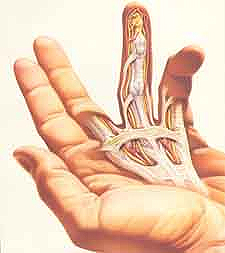Dupuytren’s Contracture
 Dupuytren’s disease is an abnormal thickening of the fascia, which is the tissue between the skin and the tendons in the palm of the hand. The disease may affect all digits but most commonly affects the middle, ring and little fingers; it may also affect the feet. This condition is most common in Caucasians with ancestors from northern Europe, and tends to run in families. Dupuytren’s disease is significantly more common in men than in women, and usually starts after age forty. This condition may first present itself as a painless lump in the palm of the hand, usually at the base of the ring or little fingers. As the disease progresses, it may cause a flexion contracture or gradual bending of the affected fingers. When the contracture becomes severe enough that the patient cannot fully extend or straighten the fingers, treatment is usually indicated. Through modern minimally invasive outpatient techniques, the diseased tissues can be freed, allowing near-full extension of the fingers and thus improving the function and appearance of the hand. In severe cases surgery and post-operative therapy may be required.
Dupuytren’s disease is an abnormal thickening of the fascia, which is the tissue between the skin and the tendons in the palm of the hand. The disease may affect all digits but most commonly affects the middle, ring and little fingers; it may also affect the feet. This condition is most common in Caucasians with ancestors from northern Europe, and tends to run in families. Dupuytren’s disease is significantly more common in men than in women, and usually starts after age forty. This condition may first present itself as a painless lump in the palm of the hand, usually at the base of the ring or little fingers. As the disease progresses, it may cause a flexion contracture or gradual bending of the affected fingers. When the contracture becomes severe enough that the patient cannot fully extend or straighten the fingers, treatment is usually indicated. Through modern minimally invasive outpatient techniques, the diseased tissues can be freed, allowing near-full extension of the fingers and thus improving the function and appearance of the hand. In severe cases surgery and post-operative therapy may be required.
Find out more on AAOS and ASSH
For more information about Dupuytren’s Contracture, click on below tab.





















